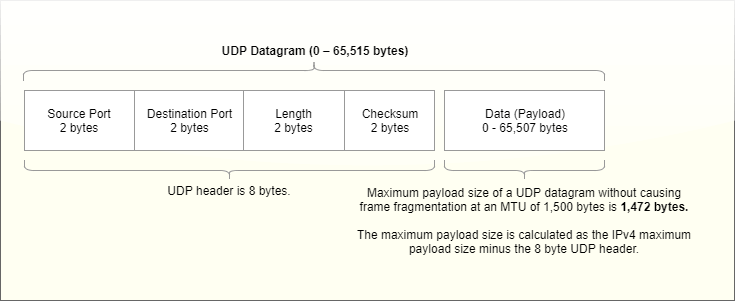
UDP packets with defined boundaries sent individually and checked for integrity on arrival Retransmission of lost packets is possibleĮxtensive error checking and acknowledgment of dataīasic error checking mechanism using checksumsĭata is read as a byte stream messages are transmitted to segment boundaries Requires an established connection to transmit data (connection should be closed once transmission is complete)Ĭonnectionless protocol with no requirements for opening, maintaining, or terminating a connectionĬan guarantee delivery of data to the destination routerĬannot guarantee delivery of data to the destination Overall, UDP is a much faster, simpler, and efficient protocol, however, retransmission of lost data packets is only possible with TCP.Īnother notable discrepancy with TCP vs UDP is that TCP provides an ordered delivery of data from user to server (and vice versa), whereas UDP is not dedicated to end-to-end communications, nor does it check the readiness of the receiver (requiring fewer overheads and taking up less space). A key difference between TCP and UDP is speed, as TCP is comparatively slower than UDP. TCP is a connection-oriented protocol, whereas UDP is a connectionless protocol. What is the Difference Between TCP and UDP?

With UDP, there is no overhead for opening a connection, maintaining a connection, or terminating a connection data is continuously sent to the recipient, whether or not they receive it.Īlthough UDP isn’t ideal for sending an email, viewing a webpage, or downloading a file, it is largely preferred for real-time communications like broadcast or multitask network transmission. User Datagram Protocol (UDP) is a simpler, connectionless Internet protocol wherein error-checking and recovery services are not required. TCP has built-in systems to check for errors and to guarantee data will be delivered in the order it was sent, making it the perfect protocol for transferring information like still images, data files, and web pages.īut while TCP is instinctively reliable, its feedback mechanisms also result in a larger overhead, translating to greater use of the available bandwidth on your network. Transmission Control Protocol (TCP) is connection-oriented, meaning once a connection has been established, data can be transmitted in two directions. Users will need to take a look at their specific IP needs to make an informed decision about which protocol is best for them.
#Udp packet header download
With that said, UDP is known for being faster and more up-to-date, yet many systems still rely on TCP to download batches of information. When it comes to TCP vs UDP features and functions, each brings its own set of advantages and challenges. The UDP packet consists of only 8 bytes for each packet.In the world of Internet protocol traffic, consumers can choose between a TCP or UDP setup for their business or personal use. The standard size of a TCP packet has a minimum size of 20 bytes, and a maximum of 60 bytes. This leads into the purpose of Header Size. TCP has a lot of things going on at once, UDP is sending out messages without being held down by things such as recovery options. Weight is what the protocol is doing to actually work. UDP is ideal for when you want quick updates (like video or audio files), and TCP is great for when you want sensitive projects (websites and file transfers). Taking those two things into account, you can see the pros and cons between the two. UDP is sending as many packets of information as possible outwards. TCP has a back and forth of information going on, and makes sure that the recieving computer isn’t being overloaded with information. TCP is slower than UDP, but that isn’t necessarily a bad thing. Below is a comic I found in the office that represents how UDP connection works (more or less). UDP is connection-less, meaning a connection is not necessarily established before data is sent. Known as a “handshake”, the client and the server will communicate. How TCP and UDP handle connections is one of the main difference’s between the two. If you’ve ever checked out the DEIPck and DEWFck examples in MPIDE, half the examples are UDP related, and the other half are TCP related, so if you want to test out the two, you can easily do so.

UDP (user datagram protocol) is light-weight and fast, and that makes it great for things like audio and video files. This makes it ideal for loading websites and other sensitive things. This is largely because, while slower then UDP, TCP is more reliable and allows for error-correction. Well, today we’re going to go over the differences between two common types of protocols (TCP and UDP). TCP (transmission control protocol) is the most standard protocol used.

Communication protocols are (in my opinion) one of the most difficult things to get a handle on when working on networking projects.


 0 kommentar(er)
0 kommentar(er)
